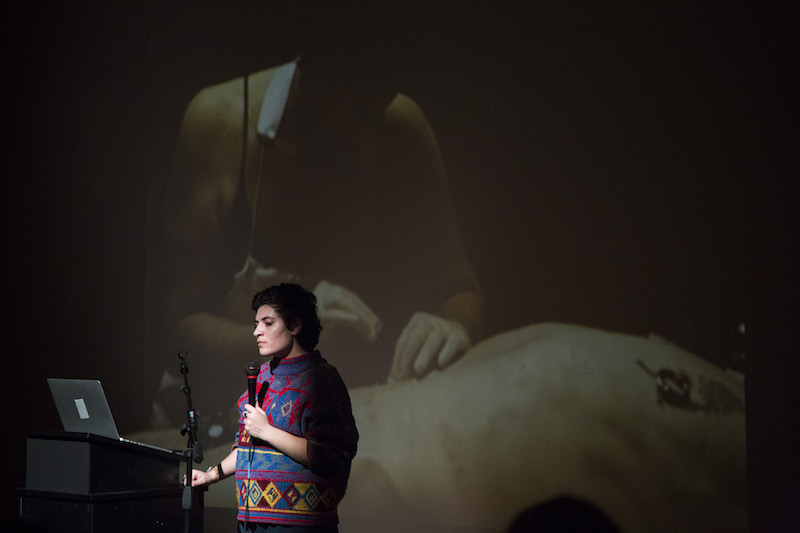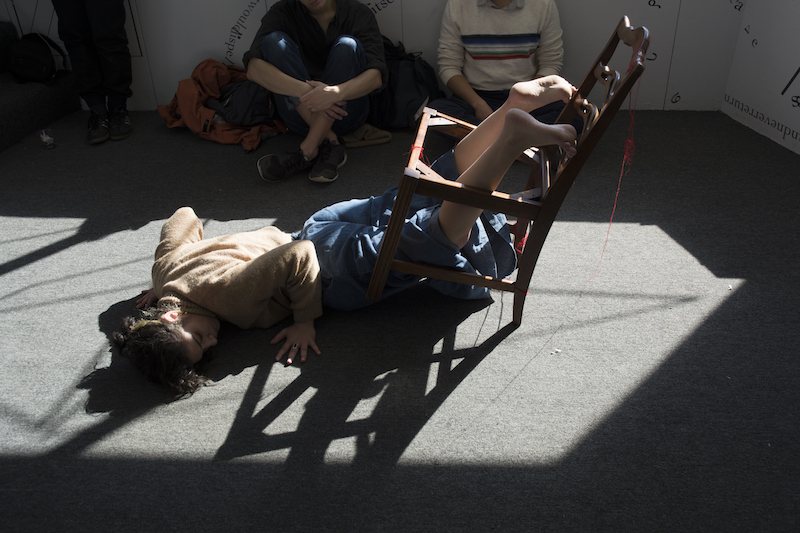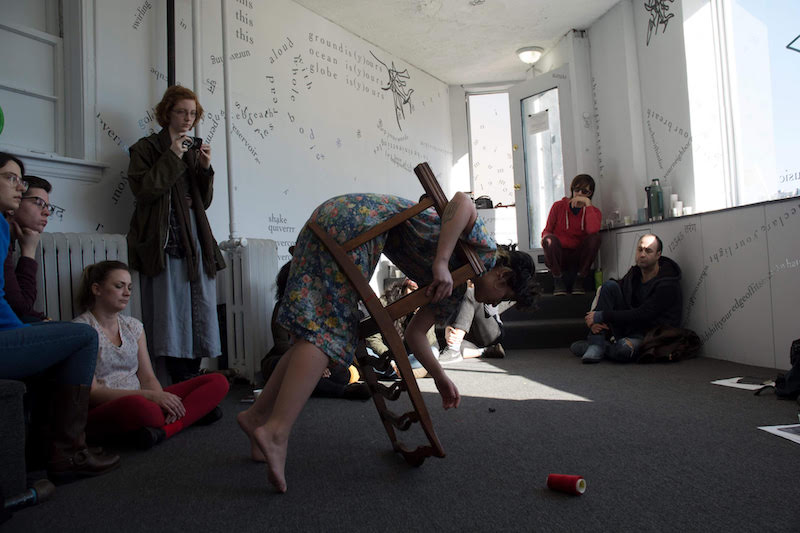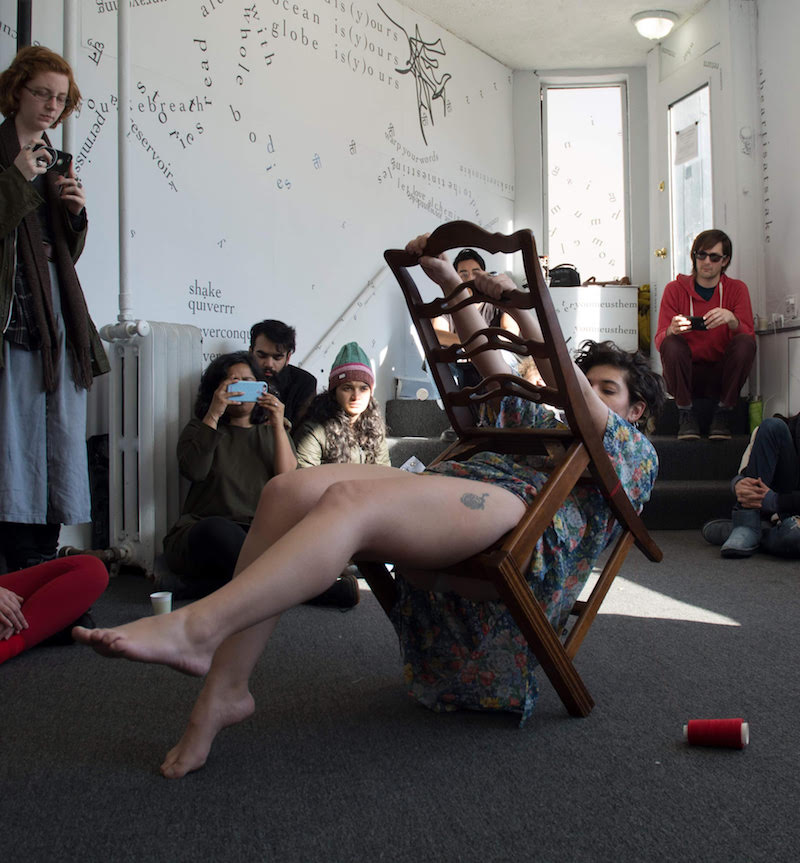Interview by Celia Wickham // Jan. 22, 2019
Tannaz Motevalli is an interdisciplinary Baltimore-based artist, whose work focuses on bodies of language, desire and identity. Her practice is highly autobiographical and shaped around her experiences of living with chronic illness, pursuing and pushing against the body’s capabilities and potentialities. In this way, there is a constant conflation and collapse of interior and exterior, as she intimately crafts performative and written work, which always feels urgent, tactile and poetic.
She is currently working as an Exhibitions Assistant at the National Library of Medicine, just outside of Washington, DC. The library houses documents, archives, rare books and manuscripts that relate to the history of medicine. We talked through this work and its relationship to her artistic practice, in particular examining the immediacy and physicality of the archive and its correlation with her body-based work. Through writing, performance and video practices, Tannaz Motevalli boldly opens herself up to the radical possibilities of shared intimacies and obsession, exploring the beauty of the everyday and the banal, alongside the poetry of the surreal and the auto-erotic.

Tannaz Motevalli: ‘3 months 28 days’, 2017, Performance at School of the Art Institute of Chicago // Courtesy of the artist
Celia Wickham: Your work over the past several years has been primarily body-based and performative in nature. In this sense, how do you feel that your practice relates to notions of touch and tactility?
Tannaz Motevalli: I think with a lot of my early practice I was making work that didn’t really engage with my physical body, or erased it in some way. I think I realised later on how much that was related to my chronic illness. That’s when I finally decided to make a piece a couple years ago about my cystic fibrosis, and how it affects my relationship to performance. I think when you feel like you have no control over your body, you feel like you want to find ways to negate it in some capacity. So a lot of my work was really anti-touch and anti-body.
After I did this piece about my illness, 3 Months and 28 Days, the work I was starting to make really paired with the way in which I was starting to focus more on myself and taking care of my body. I started exercising, for example, and became very conscious of the fact that just because I’m ill it doesn’t mean my body can’t do things. I wanted to start pushing those limits because I had never tried that before, and through doing this I realised that I really love moving in a way that is unexpected for my body. I began to start recognising ways that I could move that were extraordinary or exciting in some way.
For example, I made a piece with this chair called Gently Off The Ground, when I had a lot of different things on my mind. I was thinking a lot about sex, as I’d just lost my virginity, and up until that point my virginity was something that had been really important to my work, so my interest in using my body changed significantly. My body-based work since then has really challenged and created surreal representations of the body in relationship to the object. So with the chair, it’s this object that can become uncanny. You recognise it as a chair, but all of a sudden it no longer looks like a chair because of the way the body is engaging with it.

Tannaz Motevalli: Part 2 performance ‘Gently off the ground’ at Roman Susan, as part of Udita Upadyaya’s solo-collaborative show nevernotmusic, Winter 2018 // Courtesy of the artist
CW: There is definitely a real sense of bodily intimacy that is portrayed through your work. I was thinking a lot about your use of the mouth as a visual signifier in your work. How it operates in both its physical and aesthetic form, but also in relation to ideas of language and personal narrative?
TM: The work that I’ve been wanting to make recently has been very much about language. Its relationship to the body and the mouth falls into this really distinct place between thought and expression, and also between auto-erotic and outwardly sexual things. I had definitely been thinking through the lens of the auto-erotic in a lot of my work, especially in relation to losing my virginity. Performing through that relationship was very much about using the mouth, using lips. I think it’s because it’s this space that’s both extremely pornographic and also extremely infantile. So it’s able to straddle two really distinct feelings that, when put together, make something that can be really disturbing but also really engaging.
The felting project that I was doing with my mouth felt very literally related to touch. It was about the way in which I could create this soft object through chewing it in my mouth. Also the production process it involved is what I was most interested in, because I really like the idea of this process that was both cyclical and internal, and had really no function at all, but was just repetitive and could go on loop forever. It was like honouring that process, or a way of investigating what it means to completely limit an organism’s function to just one function that continually produces and produces. Sometimes I feel that way about language too, in that I can say something in as many ways as possible and it’s not going to stop being interesting to me. I think that’s really exciting and anti-capitalist, in the way it honours a certain type of labour that’s not often honoured.
CW: With the work that you’re doing right now as Exhibitions Assistant at the National Library of Medicine, do you feel like there is a relationship to your art practice?
TM: I think that working at the National Museum of Surgical Science in Chicago last year was really when I started to realise that I enjoyed library work a lot, and that immediate access it gives you to what are thought of as inaccessible artifacts and documents. The physicality of those things was really exciting for me. Right now I’m just enjoying sifting through all of these medical documents, and synthesising them.
I also got to a point where I didn’t know how to engage in the art world in ways that didn’t go against my instincts, especially as someone who’s really introverted. Then, there are times when my body tells me that I can’t do certain things, so I think being ill has definitely been a part of it. I also felt that my writing practice really required me to have access to libraries and archives, and I thought if I could work in that environment, get a full time job in that environment, that can get me healthcare by the time I’m 26, it can be a way to stay relevant without having to be in the center of everything all the time.
I feel like in the arts you’re either in the center or you’re on the outside, not necessarily logistically, but I think that’s how a lot of artists feel. Also the kind of community engagement work in libraries just continues to get more and more exciting, and the ways in which people are using archives and libraries to produce cultural products, it’s all becoming really creative.


Tannaz Motevalli: Part 1 performance Gently off the ground at Roman Susan, as part of Udita Upadyaya’s solo-collaborative show nevernotmusic,
Winter 2018 // Courtesy of the artist
CW: Even though you talk about your work and your practice being very disparate from each other, I see a correlation between the immediacy of the archive and its accessibility, that ties in with the tactile and immediate nature of your work, and performance practices in general. Even your work that isn’t performance-based still has a physicality to it that I find really interesting.
TM: The one thing I can always say about my work is that it’s made from a place of urgency, where I constantly need to be engaging with my thoughts to produce something. I spend so much time incubating until something triggers me into working, or the immediate creative process. I do also want my work to be as accessible as possible, in that there’s always an immediate affect the audience can engage in, that it’s not overly coded and there’s always something emotionally engaging about it. That, for me, is where I think that tactility comes in because I do think that we can make our emotions really tactile and visceral, and that’s something I always want to hold on to. You don’t have to pretend that really academic work is going to be understood by everyone, but it can still be moving or inspiring to an individual no matter how knowledgeable the audience is of that particular subject.
The work that I made about my chronic illness (3 Months and 28 Days) was really personal. I suppose my work is always really personal. I’ve always felt like when I make my work I cut myself open in a way. I also just like that image because it really explains the way I feel about myself sometimes. I can’t make something until I feel like it’s really cutting me open. That piece about my illness felt the most that way because I was talking about something, which I ended up feeling very insecure or guilty about making into an art piece, which ended up becoming a huge part of the content for that work. I didn’t know how to engage with it without being super frank and honest, and I think the language in that piece is where the accessibility comes in. Even the content, to understand illness and suffering is extremely universal to the human condition and mortality, and that all came into that piece. I remember thinking, in the end no matter how much I try to make this into an art piece, it’s still just me telling you the way that it is, as it is.
CW: I guess that piece is the one that stands out as being most autobiographical or directly linked to your experience of living with cystic fibrosis. Do you feel like your illness is something that informs or affects the way you think about making work?
TM: My work is always highly autobiographical. I mean I don’t think I can say anything about anything else other than myself, which is I think a very common feeling. I also really love the sort of internal process and reasoning that takes place when an artist is continually making work about themselves. Depending on the way that you do it, it can be very self-satisfying, but I really love obsessively internal work. I think the majority of the writers I read are women who are very obsessive, women like Clarice Lispector, Sophie Calle, Lydia Davis, Anaïs Nin, Maggie Nelson: they’re all people who are trying to engage with the outside world but they can’t do it in any other way than through their body and their own experience.
I was having a conversation with a friend recently about The Argonauts by Maggie Nelson, and how she talks about these everyday and banal things that she finds personally moving, and engages them in critical theory. The thing that I like about these women is that they’re all very academic individuals, whose writing is very myopic at times but also really abstract, where the self works as a filter between their writing and life. I feel like that’s a very realistic depiction of how I want to make work, and how I instinctively make work. I think it’s more honest in that I can’t escape my subjectivity, and I want to honour that distance between myself and the outside world. My work is always using the self as some kind of filter. Maybe that’s really where touch comes in, in that I think my physical body often becomes the filter, the mouth becomes the filter, but it also sometimes becomes a hole or an entrance point as well.
I often feel like I need some physical framework or structure when I’m making work, in order to elevate the content because often it comes out of something extremely banal or mundane, which I think shows the power and ability of art making, to turn something small into something much larger. I get frustrated with people who get annoyed at artists for making work about mundane things, because that’s just as exciting and engaging for me. I love it when people do that, and that’s why I continue to do it too. It’s a really celebratory way of making work.
This article is part of our monthly topic of ‘Touch.’ To read more from this topic, click here.























